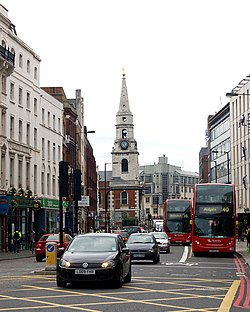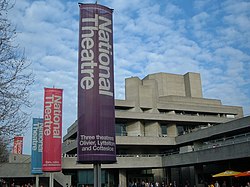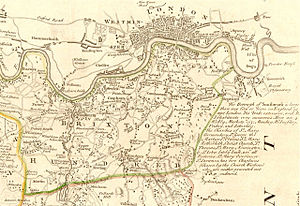Brixton Hundred: Difference between revisions
mNo edit summary |
No edit summary |
||
| (3 intermediate revisions by the same user not shown) | |||
| Line 2: | Line 2: | ||
[[File:National Theatre, South Bank Centre - geograph.org.uk - 251553.jpg|right|thumb|250px|The South Bank Centre]] | [[File:National Theatre, South Bank Centre - geograph.org.uk - 251553.jpg|right|thumb|250px|The South Bank Centre]] | ||
[[File:Brixton Hundred.jpg|thumb|300px|Brixton Hundred from an engraving by Eman Bowen, c.1760]] | [[File:Brixton Hundred.jpg|thumb|300px|Brixton Hundred from an engraving by Eman Bowen, c.1760]] | ||
The '''Brixton Hundred''' is in the | The '''Brixton Hundred''' is in the north-east of [[Surrey]], a hundred now encompassing the most urbanised parts of the county, its area entirely absorbed by the metropolitan conurbation grown out of [[London]]. Its name is from the town of [[Brixton]]. It is the most populous of the hundreds, with a population of 1,081,419 in 2011. | ||
The metropolitan parts of Surrey are neatly | The metropolitan parts of Surrey are neatly comprised in the Brixton, [[Wallington Hundred|Wallington]] and [[Kingston Hundred|Kingston]] Hundreds, and of these the Brixton Hundred, along the [[River Thames|Thames]] from [[East Sheen|Sheen]] to [[Rotherhithe]], contains some of the county's most wealthy areas and its most deprived. | ||
The [[City of London]] stands opposite | The [[City of London]] stands opposite [[Southwark]] in this hundred, joined by [[London Bridge]], along which bridge has passed a the commerce which brought wealth and eventually its counterpart to the Brixton Hundred, and across which the metropolitan growth spread which swiftly subsumed the whole hundred and moved on to Surrey's further fields. Now there are many bridges over the river joining the Surrey towns of the Brixton Hundred to those of London. | ||
==Parishes and places== | ==Parishes and places== | ||
| Line 13: | Line 13: | ||
*[[Bermondsey]] (also later [[Rotherhithe]]); | *[[Bermondsey]] (also later [[Rotherhithe]]); | ||
*[[Camberwell]]; | *[[Camberwell]]; | ||
*[[Hatcham]]; | *[[Hatcham]] chapelry in [[Deptford]] parish (otherwise in Kent); | ||
*[[Lambeth]]; | *[[Lambeth]]; | ||
*[[Walworth, Surrey|Walworth]]; | *[[Walworth, Surrey|Walworth]]; | ||
| Line 23: | Line 23: | ||
*[[Wandsworth]].<ref name=British>[http://www.british-history.ac.uk/report.asp?compid=43023 British History Online] - The hundred of Brixton</ref> | *[[Wandsworth]].<ref name=British>[http://www.british-history.ac.uk/report.asp?compid=43023 British History Online] - The hundred of Brixton</ref> | ||
The northern boundary with [[Middlesex]] is the [[River Thames]]. Within Surrey it | The northern boundary with [[Middlesex]] is the [[River Thames]]. Within Surrey it is bounded by [[Wallington Hundred]] to the south and [[Kingston Hundred]] to the west.<ref name=brit_map>{{brithist|43023|Map of Brixton hundred}}</ref> In the east its boundary is with [[Kent]] (the [[Blackheath Hundred, Kent|Blackheath Hundred]]). | ||
==History== | ==History== | ||
| Line 32: | Line 32: | ||
In 1831, the hundred was recorded with an area of 30,400 acres.<ref>[http://www.visionofbritain.org.uk/data_cube_table_page.jsp?data_theme=T_POP&data_cube=N_AREA_A&u_id=10206194&c_id=10001043&add=Y Vision of Britain] - Brixton hundred - area ([http://www.visionofbritain.org.uk/bound_map_page.jsp?first=true&u_id=10206194&c_id=10001043 historic map])</ref> Most of the hundred (except Barnes, Merton, Mortlake and Wimbledon) was included in 1829 in the Metropolitan Police District by the Metropolitan Police Act 1829 and in 1840 the rest of the hundred was included by the Metropolitan Police Act 1839. | In 1831, the hundred was recorded with an area of 30,400 acres.<ref>[http://www.visionofbritain.org.uk/data_cube_table_page.jsp?data_theme=T_POP&data_cube=N_AREA_A&u_id=10206194&c_id=10001043&add=Y Vision of Britain] - Brixton hundred - area ([http://www.visionofbritain.org.uk/bound_map_page.jsp?first=true&u_id=10206194&c_id=10001043 historic map])</ref> Most of the hundred (except Barnes, Merton, Mortlake and Wimbledon) was included in 1829 in the Metropolitan Police District by the Metropolitan Police Act 1829 and in 1840 the rest of the hundred was included by the Metropolitan Police Act 1839. | ||
In 1851 the hundred is recorded as being treated for administrative purposes as comprising an ''Eastern division'' (including Lambeth) of 22,186 acres and a population of 314,815 and ''Western division'' (including Wandsworth) of 7,699 acres and a population of 9,552. The population in 1861 is recorded as 409,504.<ref>John Marius Wilson's ''Imperial Gazetteer of England and Wales'' , (1870-72)</ref> In 1887 the hundred's area was measured at | In 1851 the hundred is recorded as being treated for administrative purposes as comprising an ''Eastern division'' (including Lambeth) of 22,186 acres and a population of 314,815 and ''Western division'' (including Wandsworth) of 7,699 acres and a population of 9,552. The population in 1861 is recorded as 409,504.<ref>John Marius Wilson's ''Imperial Gazetteer of England and Wales'' , (1870-72)</ref> In 1887 the hundred's area was measured at 29,714 acres, with a population of 825,155.<ref>John Bartholomew, ''Gazetteer of the British Isles'', (1887)</ref> | ||
[[File:Southwark aerial.JPG|right|thumb|200px|London and Southwark]] | [[File:Southwark aerial.JPG|right|thumb|200px|London and Southwark]] | ||
| Line 38: | Line 38: | ||
{{Reflist}} | {{Reflist}} | ||
[[Category: | {{Surrey hundreds}} | ||
[[Category:Metropolitan Surrey]] | |||
Latest revision as of 14:44, 30 December 2018



The Brixton Hundred is in the north-east of Surrey, a hundred now encompassing the most urbanised parts of the county, its area entirely absorbed by the metropolitan conurbation grown out of London. Its name is from the town of Brixton. It is the most populous of the hundreds, with a population of 1,081,419 in 2011.
The metropolitan parts of Surrey are neatly comprised in the Brixton, Wallington and Kingston Hundreds, and of these the Brixton Hundred, along the Thames from Sheen to Rotherhithe, contains some of the county's most wealthy areas and its most deprived.
The City of London stands opposite Southwark in this hundred, joined by London Bridge, along which bridge has passed a the commerce which brought wealth and eventually its counterpart to the Brixton Hundred, and across which the metropolitan growth spread which swiftly subsumed the whole hundred and moved on to Surrey's further fields. Now there are many bridges over the river joining the Surrey towns of the Brixton Hundred to those of London.
Parishes and places
The hundred contains the ancient parishes of:
- Battersea (including the detached part of Penge);
- Bermondsey (also later Rotherhithe);
- Camberwell;
- Hatcham chapelry in Deptford parish (otherwise in Kent);
- Lambeth;
- Walworth;
- Streatham;
- Barnes;
- Merton
- Mortlake (also later Wimbledon and Putney);
- Tooting and
- Wandsworth.[1]
The northern boundary with Middlesex is the River Thames. Within Surrey it is bounded by Wallington Hundred to the south and Kingston Hundred to the west.[2] In the east its boundary is with Kent (the Blackheath Hundred).
History
The name "Brixton" is first recorded as Brixiges stan in 1062, meaning Beorhtsige's stone, which stone might have been where early hundred meetings took place.[3] Gower suggests that the stone was located at the boundary of Streatham, Clapham and Lambeth parishes.
A nearby location on Brixton Hill became the location for the hundred gallows. Brixton Hill had been known as Bristowe Causeway long before the modern Brixton area was developed. The Surrey House of Correction, now known as Brixton Prison, was opened there in 1820.
In 1831, the hundred was recorded with an area of 30,400 acres.[4] Most of the hundred (except Barnes, Merton, Mortlake and Wimbledon) was included in 1829 in the Metropolitan Police District by the Metropolitan Police Act 1829 and in 1840 the rest of the hundred was included by the Metropolitan Police Act 1839.
In 1851 the hundred is recorded as being treated for administrative purposes as comprising an Eastern division (including Lambeth) of 22,186 acres and a population of 314,815 and Western division (including Wandsworth) of 7,699 acres and a population of 9,552. The population in 1861 is recorded as 409,504.[5] In 1887 the hundred's area was measured at 29,714 acres, with a population of 825,155.[6]

References
- ↑ British History Online - The hundred of Brixton
- ↑ Map of Brixton hundred
- ↑ Brixges Stane, the Meeting Place of the Brixton Hundred in Surrey, Graham Gower, Local History Publications 1996 ISBN 978-1-873520-20-8
- ↑ Vision of Britain - Brixton hundred - area (historic map)
- ↑ John Marius Wilson's Imperial Gazetteer of England and Wales , (1870-72)
- ↑ John Bartholomew, Gazetteer of the British Isles, (1887)
| Hundreds of Surrey |
|---|
|
Blackheath • Brixton • Copthorne • Effingham (half) • Elmbridge • Farnham • Godalming • Godley • Kingston • Reigate • Tandridge • Wallington • Woking • Wotton |